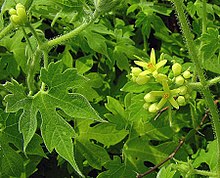
The Cornales are an order of flowering plants, early diverging among the asterids, containing about 600 species. Plants within the Cornales usually have four-parted flowers, drupaceous fruits, and inferior to half-inferior gynoecia topped with disc-shaped nectaries.

Bartonia is a genus of the gentian family, tribe Gentianeae, subtribe Swertiinae. Members of this genus are called screwstems. Bartonia was also the name of a genus in the Loasaceae family, but those species are now generally classified under the genus Mentzelia.

Loasa is a genus of ornamental plants in the family Loasaceae. These plants are usually prickly herbs, or subshrubs, and they are native to tropical America.
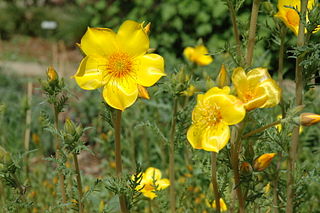
Mentzelia is a genus of about 60-70 species of flowering plants in the family Loasaceae, native to the Americas. The genus comprises annual, biennial, and perennial herbaceous plants and a few shrubs.

Loasaceae is a family of 15–20 genera and about 200–260 species of flowering plants in the order Cornales, native to the Americas and Africa. Members of the family include annual, biennial and perennial herbaceous plants, and a few shrubs and small trees.
Nasa auca is a species of plant in the Loasaceae family. It is endemic to Ecuador. Its natural habitat is subtropical or tropical moist montane forests.
Nasa connectans is a species of plant in the Loasaceae family. It is endemic to Ecuador. Its natural habitat is subtropical or tropical moist montane forests.
Nasa ferox is a species of plant in the Loasaceae family. It is endemic to Ecuador. Its natural habitat is subtropical or tropical moist montane forests.
Nasa glabra is a species of plant in the Loasaceae family. It is endemic to Ecuador. Its natural habitat is subtropical or tropical moist montane forests.
Nasa humboldtiana is a species of plant in the Loasaceae family. It is endemic to Ecuador. Its natural habitat is subtropical or tropical moist montane forests.
Nasa loxensis is a species of plant in the Loasaceae family. It is endemic to Ecuador. Its natural habitat is subtropical or tropical moist montane forests.
Nasa modesta is a species of plant in the Loasaceae family. It is endemic to Ecuador. Its natural habitat is subtropical or tropical moist montane forests.
Nasa tabularis is a species of plant in the Loasaceae family. It is endemic to Ecuador. Its natural habitat is subtropical or tropical moist montane forests.
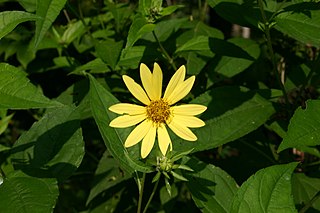
Helianthus × laetiflorus, the cheerful sunflower or perennial sunflower, is a plant in the daisy family, Asteraceae. It is widespread in scattered locations across much of Canada from Newfoundland to British Columbia, and the central and eastern United States as far south as Texas and Georgia.

Nasa is a genus of plants in the family Loasaceae containing over 100 known species, all of which are found in South America with the exception of two species endemic to Central America. They are common in submontane to montane environments.
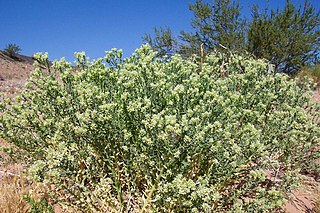
Petalonyx thurberi is a species of flowering plant in the family Loasaceae known by the common names Thurber's sandpaper plant and common sandpaper plant. It is native to the deserts of the southwestern United States and northwestern Mexico, where it grows in sandy and scrubby habitat. It is a rounded or spreading, clumpy subshrub made up of many rough-haired stems approaching one meter in maximum height. The stems are lined with clasping leaves varying in shape from lance-shaped to triangular to oval and sometimes toothed. The inflorescence at the end of the stem is a small, crowded raceme of several flowers. The white flower appears tubular, its petals fused near the spreading tips but open lower, the stamens emerging from outside the corolla.
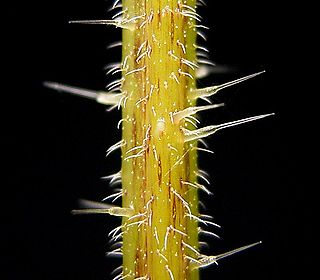
A stinging plant or a plant with stinging hairs is a plant with hairs (trichomes) on its leaves or stems that are capable of injecting substances that cause pain or irritation.

Solidago puberula, the downy goldenrod, is a plant species native to eastern North America from Nova Scotia and Ontario south to Florida and Louisiana. Two subspecies are commonly recognized:

Bidens beckii, commonly called Beck's water-marigold or simply water marigold is a species of flowering plant in the daisy family. It is native to Canada and the northern United States.
Fuertesia is a genus of flowering plants in the family Loasaceae. It has only one currently accepted species, Fuertesia domingensis, native to Hispaniola. It is a woody climbing liana.
